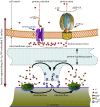Surface modification of biomaterials using plasma immersion ion implantation and deposition
- PMID: 23741609
- PMCID: PMC3363023
- DOI: 10.1098/rsfs.2012.0003
Surface modification of biomaterials using plasma immersion ion implantation and deposition
Abstract
Although remarkable progress has been made on biomaterial research, the ideal biomaterial that satisfies all the technical requirements and biological functions is not available up to now. Surface modification seems to be a more economic and efficient way to adjust existing conventional biomaterials to meet the current and ever-evolving clinical needs. From an industrial perspective, plasma immersion ion implantation and deposition (PIII&D) is an attractive method for biomaterials owing to its capability of treating objects with irregular shapes, as well as the control of coating composition. It is well acknowledged that the physico-chemical characteristics of biomaterials are the decisive factors greatly affecting the biological responses of biomaterials including bioactivity, haemocompatibility and antibacterial activity. Here, we mainly review the recent advances in surface modification of biomaterials via PIII&D technology, especially titanium alloys and polymers used for orthopaedic, dental and cardiovascular implants. Moreover, the variations of biological performances depending on the physico-chemical properties of modified biomaterials will be discussed.
Keywords: antibacterial activity; bioactivity; haemocompatibility; physico-chemical characteristics; plasma immersion ion implantation and deposition; surface modification.
Figures






Similar articles
-
Surface modifications of biomaterials in different applied fields.RSC Adv. 2023 Jul 10;13(30):20495-20511. doi: 10.1039/d3ra02248j. eCollection 2023 Jul 7. RSC Adv. 2023. PMID: 37435384 Free PMC article. Review.
-
Effects of carbon and nitrogen plasma immersion ion implantation on bioactivity of zirconia.RSC Adv. 2020 Sep 30;10(59):35917-35929. doi: 10.1039/d0ra05853j. eCollection 2020 Sep 28. RSC Adv. 2020. PMID: 35517098 Free PMC article.
-
Multifunctions of dual Zn/Mg ion co-implanted titanium on osteogenesis, angiogenesis and bacteria inhibition for dental implants.Acta Biomater. 2017 Feb;49:590-603. doi: 10.1016/j.actbio.2016.11.067. Epub 2016 Nov 30. Acta Biomater. 2017. PMID: 27915020
-
Bioactivity and antibacterial effect of nitrogen plasma immersion ion implantation on polyetheretherketone.Dent Mater. 2016 Nov;32(11):e263-e274. doi: 10.1016/j.dental.2016.08.215. Epub 2016 Aug 28. Dent Mater. 2016. PMID: 27578287
-
Understanding and optimizing the antibacterial functions of anodized nano-engineered titanium implants.Acta Biomater. 2021 Jun;127:80-101. doi: 10.1016/j.actbio.2021.03.027. Epub 2021 Mar 17. Acta Biomater. 2021. PMID: 33744499 Review.
Cited by
-
Low-Temperature Plasma Techniques in Biomedical Applications and Therapeutics: An Overview.Int J Mol Sci. 2023 Dec 30;25(1):524. doi: 10.3390/ijms25010524. Int J Mol Sci. 2023. PMID: 38203693 Free PMC article. Review.
-
Surface modifications of biomaterials in different applied fields.RSC Adv. 2023 Jul 10;13(30):20495-20511. doi: 10.1039/d3ra02248j. eCollection 2023 Jul 7. RSC Adv. 2023. PMID: 37435384 Free PMC article. Review.
-
Research progress of metal biomaterials with potential applications as cardiovascular stents and their surface treatment methods to improve biocompatibility.Heliyon. 2024 Feb 7;10(4):e25515. doi: 10.1016/j.heliyon.2024.e25515. eCollection 2024 Feb 29. Heliyon. 2024. PMID: 38375258 Free PMC article. Review.
-
The effect of plasma surface treatment on the bioactivity of titanium implant materials (in vitro).J Int Soc Prev Community Dent. 2016 Jan-Feb;6(1):15-21. doi: 10.4103/2231-0762.171592. J Int Soc Prev Community Dent. 2016. PMID: 27011927 Free PMC article.
-
Atmospheric Pressure Plasma Polymerization Synthesis and Characterization of Polyaniline Films Doped with and without Iodine.Materials (Basel). 2017 Nov 6;10(11):1272. doi: 10.3390/ma10111272. Materials (Basel). 2017. PMID: 29113129 Free PMC article.
References
-
- Hench L. L. 1980. Biomaterials. Science 208, 826–83110.1126/science.6246576 (doi:10.1126/science.6246576) - DOI - DOI - PubMed
-
- Hench L. L., Wilson J. 1984. Surface-active biomaterials. Science 226, 630–63610.1126/science.6093253 (doi:10.1126/science.6093253) - DOI - DOI - PubMed
-
- Hench L. L., Polak J. M. 2002. Third-generation biomedical materials. Science 295, 1014–101710.1126/science.1067404 (doi:10.1126/science.1067404) - DOI - DOI - PubMed
-
- Narayan R. J. 2010. The next generation of biomaterial development. Phil. Trans. R. Soc. A 368, 1831–183710.1098/rsta.2010.0001 (doi:10.1098/rsta.2010.0001) - DOI - DOI - PubMed
-
- Griffith L. G., Naughton G. 2002. Tissue engineering: current challenges and expanding opportunities. Science 295, 1009–101410.1126/science.1069210 (doi:10.1126/science.1069210) - DOI - DOI - PubMed
LinkOut - more resources
Full Text Sources
Other Literature Sources

